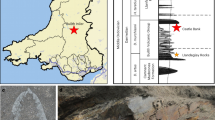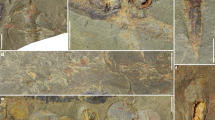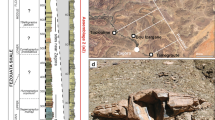Abstract
The renowned soft-bodied faunas of the Cambrian period, which include the Burgess Shale, disappear from the fossil record in the late Middle Cambrian, after which the Palaeozoic fauna1 dominates. The disappearance of faunas of Burgess Shale type curtails the stratigraphic record of a number of iconic Cambrian taxa. One possible explanation for this loss is a major extinction2,3, but more probably it reflects the absence of preservation of similar soft-bodied faunas in later periods4. Here we report the discovery of numerous diverse soft-bodied assemblages in the Lower and Upper Fezouata Formations (Lower Ordovician) of Morocco, which include a range of remarkable stem-group morphologies normally considered characteristic of the Cambrian. It is clear that biotas of Burgess Shale type persisted after the Cambrian and are preserved where suitable facies occur. The Fezouata biota provides a link between the Burgess Shale communities and the early stages of the Great Ordovician Biodiversification Event.
This is a preview of subscription content, access via your institution
Access options
Subscribe to this journal
Receive 51 print issues and online access
$199.00 per year
only $3.90 per issue
Buy this article
- Purchase on Springer Link
- Instant access to full article PDF
Prices may be subject to local taxes which are calculated during checkout


Similar content being viewed by others
References
Sepkoski, J. J. A kinetic model of Phanerozoic taxonomic diversity II. Early Phanerozoic families and multiple equilibria. Paleobiology 5, 222–251 (1979)
Conway Morris, S. The persistence of Burgess Shale-type faunas: implications for the evolution of deeper-water faunas. Trans. R. Soc. Edinb. Earth Sci. 80, 271–283 (1989)
Bambach, R. K., Knoll, A. H. & Wang, S. C. Origination, extinction, and mass depletions of marine diversity. Paleobiology 30, 522–542 (2004)
Allison, P. A. & Briggs, D. E. G. Exceptional fossil record: distribution of soft-tissue preservation through the Phanerozoic. Geology 21, 527–530 (1993)
Farrell, U. C., Martin, M. J., Hagadorn, J. W., Whiteley, T. & Briggs, D. E. G. Beyond Beecher’s Trilobite Bed: Widespread pyritization of soft-tissues in the Late Ordovician Taconic Foreland Basin. Geology 37, 907–910 (2009)
Aldridge, R. J., Gabbott, S. E. & Theron, J. N. in Palaeobiology II (eds Briggs, D. E. G. & Crowther, P. R.) 340–342 (Blackwell, 2001)
Liu, H. P. et al. A new Lagerstätte from the Middle Ordovician St. Peter Formation in northeastern Iowa, USA. Geology 34, 969–972 (2006)
Young, G. A., Rudkin, D. M., Dobrzanski, E. P., Robson, S. P. & Nowlan, G. S. Exceptionally preserved Late Ordovician biotas from Manitoba, Canada. Geology 35, 883–886 (2007)
Droser, M. L. & Finnegan, S. The Ordovician radiation: a follow-up to the Cambrian explosion? Integr. Comp. Biol. 43, 178–184 (2003)
Webby, B. D., Paris, F., Droser, M. L. & Percival, I. G. eds. The Great Ordovician Biodiversification Event (Columbia Univ. Press, 2004)
Harper, D. A. T. The Ordovician biodiversification: setting an agenda for marine life. Palaeogeogr. Palaeoclimatol. Palaeoecol. 232, 148–166 (2006)
Bambach, R. K., Bush, A. M. & Erwin, D. H. Autecology and the filling of ecospace: key metazoan radiations. Palaeontology 50, 1–22 (2007)
Vandenbroucke, T. R. A., Gabbott, S. E., Paris, F., Aldridge, R. J. & Theron, J. N. Chitinozoans and the age of the Soom Shale, an Ordovician black shale Lagerstätte, South Africa. J. Micropalaeontol. 28, 53–66 (2009)
Destombes, J., Hollard, H. & Willefert, S. in Lower Palaeozoic Rocks of the World Vol. 4, Lower Palaeozoic of North-Western and West-Central Africa (ed. Holland, C. H.) 91–336 (Wiley & Sons, 1985)
Zhang, X.-G., Bergström, J., Bromley, R. G. & Hou, X.-G. Diminutive trace fossils in the Chengjiang Lagerstätte. Terra Nova 19, 407–412 (2007)
Vinther, J., Van Roy, P. & Briggs, D. E. G. Machaeridians are Palaeozoic armoured annelids. Nature 451, 185–188 (2008)
Gabbott, S. E., Hou, X.-G., Norry, M. J. & Siveter, D. J. Preservation of Early Cambrian animals of the Chengjiang biota. Geology 32, 901–904 (2004)
Clausen, S., Hou, X.-G., Bergström, J. & Franzén, C. The absence of echinoderms from the Lower Cambrian Chengjiang fauna of China: palaeoecological and palaeogeographical implications. Palaeogeogr. Palaeoclimatol. Palaeoecol. 10.1016/j.palaeo.2010.01.001 (published online 7 January 2010)
Botting, J. P. ‘Cambrian’ demosponges in the Ordovician of Morocco: insights into the early evolution of sponges. Geobios 40, 737–748 (2007)
Butterfield, N. J. Secular distribution of Burgess Shale-type preservation. Lethaia 28, 1–13 (1995)
Allison, P. A. & Briggs, D. E. G. in Taphonomy: Releasing Data Locked in the Fossil Record (eds Allison, P. A. & Briggs, D. E. G.) 25–70 (Plenum, 1991)
Allison, P. A. & Briggs, D. E. G. Burgess Shale-type biotas burrowed away? Lethaia 26, 184–185 (1993)
Orr, P. J., Benton, M. J. & Briggs, D. E. G. Post-Cambrian closure of the deep-water slope-basin taphonomic window. Geology 31, 769–772 (2003)
Conway Morris, S. Cambrian Lagerstätten: their distribution and significance. Phil. Trans. R. Soc. Lond. B 311, 49–65 (1985)
Caron, J.-B., Rudkin, D. M. & Miliken, S. A new Late Silurian (Přidolian) naraoiid (Euarthropoda: Nektaspida) from the Bertie Formation of Southern Ontario, Canada — delayed fallout from the Cambrian Explosion. J. Paleontol. 78, 1138–1145 (2004)
Kühl, G., Bergström, J. & Rust, J. Morphology, palaeobiology and phylogenetic position of Vachonisia rogeri (Arthropoda) from the Devonian Hunsrück Slate (Germany). Palaeontogr. Abt. A 286, 123–157 (2008)
Kühl, G., Briggs, D. E. G. & Rust, J. A great appendage arthropod with a radial mouth from the Lower Devonian Hunsrück Slate, Germany. Science 323, 771–773 (2009)
Friend, D., Zhuravlev, A., Yu & Solov’ev, I. A. Middle Cambrian Eldonia from the Siberian Platform. Paleontol. J. 36, 20–24 (2002)
Alessandrello, A. & Bracchi, G. Eldonia berbera n. sp., a new species of the enigmatic genus Eldonia Walcott, 1911 from the Rawtheyan (Upper Ordovician) of Anti-Atlas (Erfoud, Tafilalt, Morocco). Atti Soc. Ital. Sci. Nat. Museo Civ. Stor. nat. Milano 144, 337–358 (2003)
Van Roy, P. An aglaspidid arthropod from the Upper Ordovician of Morocco with remarks on the affinities and limitations of Aglaspidida. Trans. R. Soc. Edinb. Earth Sci. 96, 327–350 (2006)
Acknowledgements
S. Butts (Yale Peabody Museum of Natural History), A. Prieur (Lyon 1 University), D. Berthet (Natural History Museum of Lyon), A. Médard-Blondel and S. Pichard (Natural History Museum of Marseille), G. Fleury (Natural History Museum of Toulouse), the National Museums of Scotland and the Sedgwick Museum provided access to specimens. M. Ben Said Ben Moula, W. and D. De Winter, B. MacGabhann, R. and V. Reboul-Baron, C. Upton, B. Van Bocxlaer, and D. and K. Van Damme assisted with fieldwork, and B. Tahiri arranged logistical support. E. Champion helped with the preparation of figures. J. De Grave and B. Van Bocxlaer (Ghent University) provided photographic equipment, and the Palaeontology and Petrology Research Units of Ghent University allowed use of their imaging facilities. P. and O. Van Roy-Lassaut financially aided fieldwork. This research was funded by an Agency for Innovation by Science and Technology (IWT) doctoral fellowship and by an Irish Research Council for Science, Engineering and Technology (IRCSET) – EMPOWER postdoctoral fellowship awarded to P.V.R. Fieldwork was supported by a National Geographic Society Research and Exploration grant.
Author information
Authors and Affiliations
Contributions
All authors carried out field work and contributed to the interpretation of the fossils. P.V.R., P.J.O., J.P.B. and D.E.G.B. wrote the paper with input from the other authors.
Corresponding authors
Ethics declarations
Competing interests
The authors declare no competing financial interests.
Supplementary information
Supplementary Figures
This file contains Supplementary Figures S1-S3 with legends. (PDF 9575 kb)
PowerPoint slides
Rights and permissions
About this article
Cite this article
Van Roy, P., Orr, P., Botting, J. et al. Ordovician faunas of Burgess Shale type. Nature 465, 215–218 (2010). https://doi.org/10.1038/nature09038
Received:
Accepted:
Issue Date:
DOI: https://doi.org/10.1038/nature09038
This article is cited by
-
The marine conservation deposits of Monte San Giorgio (Switzerland, Italy): the prototype of Triassic black shale Lagerstätten
Swiss Journal of Palaeontology (2024)
-
The Cabrières Biota (France) provides insights into Ordovician polar ecosystems
Nature Ecology & Evolution (2024)
-
Rhabdopleurid epibionts from the Ordovician Fezouata Shale biota and the longevity of cross-phylum interactions
Communications Biology (2023)
-
A Middle Ordovician Burgess Shale-type fauna from Castle Bank, Wales (UK)
Nature Ecology & Evolution (2023)
-
New fossil assemblages from the Early Ordovician Fezouata Biota
Scientific Reports (2022)
Comments
By submitting a comment you agree to abide by our Terms and Community Guidelines. If you find something abusive or that does not comply with our terms or guidelines please flag it as inappropriate.



